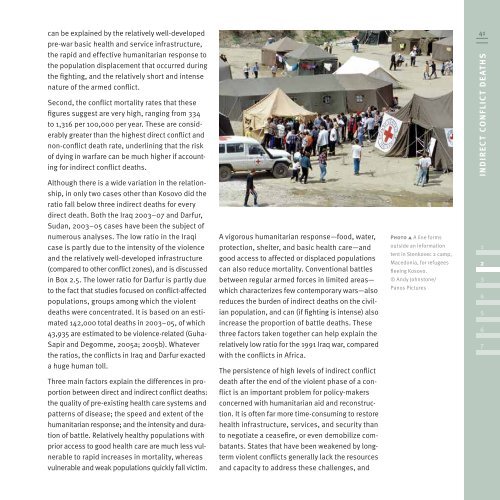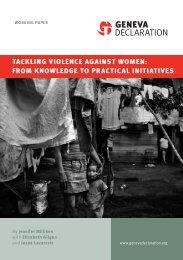Global Burden of Armed Violence - The Geneva Declaration on ...
Global Burden of Armed Violence - The Geneva Declaration on ...
Global Burden of Armed Violence - The Geneva Declaration on ...
You also want an ePaper? Increase the reach of your titles
YUMPU automatically turns print PDFs into web optimized ePapers that Google loves.
can be explained by the relatively well-developed<br />
pre-war basic health and service infrastructure,<br />
the rapid and effective humanitarian resp<strong>on</strong>se to<br />
the populati<strong>on</strong> displacement that occurred during<br />
the fighting, and the relatively short and intense<br />
nature <str<strong>on</strong>g>of</str<strong>on</strong>g> the armed c<strong>on</strong>flict.<br />
Sec<strong>on</strong>d, the c<strong>on</strong>flict mortality rates that these<br />
figures suggest are very high, ranging from 334<br />
to 1,316 per 100,000 per year. <str<strong>on</strong>g>The</str<strong>on</strong>g>se are c<strong>on</strong>siderably<br />
greater than the highest direct c<strong>on</strong>flict and<br />
n<strong>on</strong>-c<strong>on</strong>flict death rate, underlining that the risk<br />
<str<strong>on</strong>g>of</str<strong>on</strong>g> dying in warfare can be much higher if accounting<br />
for indirect c<strong>on</strong>flict deaths.<br />
Although there is a wide variati<strong>on</strong> in the relati<strong>on</strong>ship,<br />
in <strong>on</strong>ly two cases other than Kosovo did the<br />
ratio fall below three indirect deaths for every<br />
direct death. Both the Iraq 2003–07 and Darfur,<br />
Sudan, 2003–05 cases have been the subject <str<strong>on</strong>g>of</str<strong>on</strong>g><br />
numerous analyses. <str<strong>on</strong>g>The</str<strong>on</strong>g> low ratio in the Iraqi<br />
case is partly due to the intensity <str<strong>on</strong>g>of</str<strong>on</strong>g> the violence<br />
and the relatively well-developed infrastructure<br />
(compared to other c<strong>on</strong>flict z<strong>on</strong>es), and is discussed<br />
in Box 2.5. <str<strong>on</strong>g>The</str<strong>on</strong>g> lower ratio for Darfur is partly due<br />
to the fact that studies focused <strong>on</strong> c<strong>on</strong>flict-affected<br />
populati<strong>on</strong>s, groups am<strong>on</strong>g which the violent<br />
deaths were c<strong>on</strong>centrated. It is based <strong>on</strong> an estimated<br />
142,000 total deaths in 2003–05, <str<strong>on</strong>g>of</str<strong>on</strong>g> which<br />
43,935 are estimated to be violence-related (Guha-<br />
Sapir and Degomme, 2005a; 2005b). Whatever<br />
the ratios, the c<strong>on</strong>flicts in Iraq and Darfur exacted<br />
a huge human toll.<br />
Three main factors explain the differences in proporti<strong>on</strong><br />
between direct and indirect c<strong>on</strong>flict deaths:<br />
the quality <str<strong>on</strong>g>of</str<strong>on</strong>g> pre-existing health care systems and<br />
patterns <str<strong>on</strong>g>of</str<strong>on</strong>g> disease; the speed and extent <str<strong>on</strong>g>of</str<strong>on</strong>g> the<br />
humanitarian resp<strong>on</strong>se; and the intensity and durati<strong>on</strong><br />
<str<strong>on</strong>g>of</str<strong>on</strong>g> battle. Relatively healthy populati<strong>on</strong>s with<br />
prior access to good health care are much less vulnerable<br />
to rapid increases in mortality, whereas<br />
vulnerable and weak populati<strong>on</strong>s quickly fall victim.<br />
A vigorous humanitarian resp<strong>on</strong>se—food, water,<br />
protecti<strong>on</strong>, shelter, and basic health care—and<br />
good access to affected or displaced populati<strong>on</strong>s<br />
can also reduce mortality. C<strong>on</strong>venti<strong>on</strong>al battles<br />
between regular armed forces in limited areas—<br />
which characterizes few c<strong>on</strong>temporary wars—also<br />
reduces the burden <str<strong>on</strong>g>of</str<strong>on</strong>g> indirect deaths <strong>on</strong> the civilian<br />
populati<strong>on</strong>, and can (if fighting is intense) also<br />
increase the proporti<strong>on</strong> <str<strong>on</strong>g>of</str<strong>on</strong>g> battle deaths. <str<strong>on</strong>g>The</str<strong>on</strong>g>se<br />
three factors taken together can help explain the<br />
relatively low ratio for the 1991 Iraq war, compared<br />
with the c<strong>on</strong>flicts in Africa.<br />
<str<strong>on</strong>g>The</str<strong>on</strong>g> persistence <str<strong>on</strong>g>of</str<strong>on</strong>g> high levels <str<strong>on</strong>g>of</str<strong>on</strong>g> indirect c<strong>on</strong>flict<br />
death after the end <str<strong>on</strong>g>of</str<strong>on</strong>g> the violent phase <str<strong>on</strong>g>of</str<strong>on</strong>g> a c<strong>on</strong>flict<br />
is an important problem for policy-makers<br />
c<strong>on</strong>cerned with humanitarian aid and rec<strong>on</strong>structi<strong>on</strong>.<br />
It is <str<strong>on</strong>g>of</str<strong>on</strong>g>ten far more time-c<strong>on</strong>suming to restore<br />
health infrastructure, services, and security than<br />
to negotiate a ceasefire, or even demobilize combatants.<br />
States that have been weakened by l<strong>on</strong>gterm<br />
violent c<strong>on</strong>flicts generally lack the resources<br />
and capacity to address these challenges, and<br />
Photo ! A line forms<br />
outside an informati<strong>on</strong><br />
tent in Stenkovec 2 camp,<br />
Maced<strong>on</strong>ia, for refugees<br />
fleeing Kosovo.<br />
© Andy Johnst<strong>on</strong>e/<br />
Panos Pictures<br />
41<br />
I N D I R EC T CO N F L I C T DE AT H S<br />
1<br />
2<br />
3<br />
4<br />
5<br />
6<br />
7









